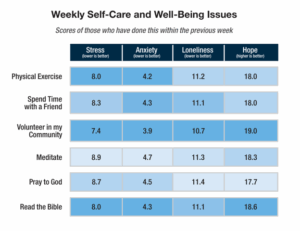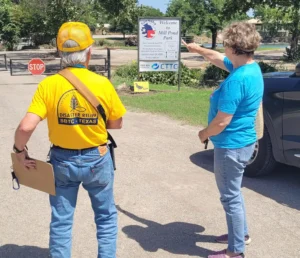
EDITOR’S NOTE: The following two stories, first carried by Baptist Press on May 12, 2010, report on a conference at New Orleans Baptist Theological Seminary in which Bible Storying was presented as a discipleship method for church-based small groups.
NEW ORLEANS (BP)–Keith Strasburger skillfully conveyed Jesus’ story of the prodigal son to the small group gathered around him. His style was easygoing and relational, yet he told the story with amazing detail and accuracy.
Strasburger and Dan Cullum led one of eight small groups during the launch of a discipleship thrust called “DNA 21” at New Orleans Baptist Theological Seminary. More than 100 participants gathered in New Orleans and via the Internet in Atlanta, Orlando, Fla., to learn about Bible storying and relational small groups as a discipleship method. The small groups played a key role in modeling the concept during the three-day DNA21 conference.
Bible storying is the art of presenting biblical content from memory. Great attention is given to preserving the details while conveying the message of Scripture. Stories are presented in an orderly fashion toward building a biblical worldview.
After telling the story, Strasburger began asking questions, leading the group to retell the biblical story. Each person contributed. When important details were missed, Strasburger or Cullum gently pointed out the missing element and moved on to the next part of the story.
To close out the hour-long small group session, Strasburger asked group members to examine their lives in light of the story. Each participant then shared how he or she was like one of the characters in the story.
This group, strangers just hours earlier, shared openly about themselves and their struggles. Not everyone shared on the same level, but the session clearly illustrated how transparency can develop around intentional small groups.
DNA 21 developed out of Avery Willis’ concern over the lack of discipleship in many churches. Willis, a former senior vice president of the International Mission Board who developed the MasterLife discipleship materials, planned the conference to promote Bible storying in relational small groups as a method of discipleship. He sees this not as a new initiative but rather a return to the way Jesus developed disciples in the first century.
“God wired us for stories. We like stories. We remember stories,” Willis said. Video examples of Bible storying are available at www.learningtosoar.org under the “Training” tab.
Bible storying has been around for more than 25 years and is commonly used on the mission field to reach oral cultures. As Willis looked at the discipleship needs of the American church, he began to see Bible storying as a viable option in the United States and other literate cultures.
Regardless of whether or not people can read, Bible storying proponents say it offers several unique advantages. Deep truths can be communicated in a short amount of time. Groups remain open to new people. Leaders are developed naturally in the group. And the method is reproducible.
And the stories are memorable, Willis noted; truths “stick” when participants are encouraged to tell the story to others within their spheres of influence.
“The processes by which you get God’s Word in the heart make a difference. Jesus just kept asking questions,” Willis said. “It is not just the telling the story as accurately as you can, it is the process of asking the right kind of questions.”
True discipleship takes more than simply imparting information and developing knowledge, it involves transformation, Willis said.
“We’ve got to get involved with people just like Jesus did. You get involved, you explain, you coach, you support and empower,” he said. The goal is to develop discipled believers who are prepared and ready to disciple others.
In 2006 pastor Jim Putman of Real Life Ministries, a church in Post Falls, Idaho, asked Willis to help develop and implement Bible storying. Willis agreed to the challenge and Real Life became a test case for the storying discipleship method.
Putman started planting Real Life Ministries in 1998, along with Aaron Couch. Dan Cullum joined the team during the church’s early days. From the beginning, the church focused on discipleship and small groups.
“Jim came from an evangelism mindset, and I came from a discipleship mindset,” Cullum said. “Discipleship flows out of a deep spiritual walk with God, and evangelism flows out of proper discipleship.”
By combining their vision, they came to realize they were working toward the same goal.
The first year of Real Life Ministries was spent in what Cullum called “alignment,” a process of working through doctrinal issues together. They had to determine where each of them stood theologically and what doctrines of the faith were essential, non-essential, negotiable and non-negotiable. To assist them, together they carefully worked through Henry Blackaby’s “Experiencing God” discipleship study.
From their study of the Gospels and Acts, they concluded that the New Testament model was built on the way Jesus developed disciples in a relational environment. He had His inner circle, the 12, and the masses. Jesus developed close relationships with 12 men, but he was particularly close with His inner circle: Peter, James and John.
The philosophy of Real Life Ministries is that in order to make disciples, Christians must be in “accountable relationship” with a small group -– just like Jesus and His disciples.
The results of Real Life’s intentional small group approach have been phenomenal. Starting with only four couples in 1998, the church now has 8,500 members, with 7,000 involved in small groups. The church has planted five additional churches. Real Life was already growing when Willis taught Bible storying to the leadership. Now, storying is a key part of the church’s discipleship groups.
During his presentation at the April 22-24 DNA 21 conference in New Orleans, Putman noted that many churches fail to define a clear goal when it comes to disciple-making. He often encounters church leadership teams that do not share a common definition of what it means to be a disciple.
“That’s the equivalent of me getting in a huddle on a football field, calling a play and everybody having their own idea of what that play means,” Putman said.
Putman cautioned against “the next new thing” mentality of some pastors. Bible storying in relational small groups is not a program, he said. Forcing change on a church can destroy it, especially if the pastor is prone to follow every new ministry trend. Putman suggested a slow, prayerful implementation process.
“Going to the right place in the wrong way is still wrong,” Putman said. “We’re just here to say ‘this is what God has taught us about discipleship.'”
Putman said relational small groups offer leaders the chance to ask and answer questions, confront and hold people accountable, and to model discipleship principles. If all these aspects do not come together, a small group will be no more effective than other attempts at discipleship, Putman said.
“Our churches should be a place where everyone is a growing disciple,” Putman said. “When that happens, a movement starts.”
–30–
Gary D. Myers is director of public relations at New Orleans Baptist Theological Seminary; Christopher J. Black is a doctoral candidate at New Orleans Seminary who will graduate with a Ph.D. in theology in May. The global launch of DNA 21 will be held in Colorado Springs Aug. 26-28. For more information, visit www.dna-21.org.
—————
Using Bible storying in a small group
By Mark Snowden
NEW ORLEANS (BP)–A typical Bible storying session follows eight steps set to the acronym S.T.O.R.Y.I.N.G.
S — Set the story context. Bridge from the previous session’s story by:
* Asking about how the group members used the story or had someone retell the story.
* Connecting a need the participants have with the main truth of the story by telling a personal experience, asking a question or showing a short video that raises the issue.
* Asking members of the group to listen for the answers to questions about the story you are about to tell.
T — Tell the Bible story; don’t embellish.
O — Observe participants to see if they’re getting it.
R – Rebuild/review the facts of the story as a group, asking “What” questions (of the head).
Y — Getting out of the way and watching the Holy Spirit work among the group members as they dialogue.
I — Internalize God’s truth by dialoging what the story means. Ask “Why” questions (of the heart).
N — Now applying the story individually and as a group (hands).
G — Go tell the story to someone else not in the group and report on it next week!
Video examples of Bible storying are available at www.learningtosoar.org under the “Training” tab.
TIPS: To strengthen a Bible storying small group, seek to involve everyone present. Maybe someone other than the leader tells the story or a few in the group act it out in an impromptu skit. You may make up a song or sing one that fits the primary message of the story to plant it in their subconscious minds. The most productive small groups that use Bible storying are those that are relational, supportive, transparent and accountable. Small group leaders quickly learn that the responsibility for learning shifts from the teacher to the student in Bible storying.
Finally, Bible stories are chosen in the first place based on the issues that a believer is addressing in real life. These are not random selections, but intentional uses of God’s Word that make disciples.
See “Truth That Sticks: How to Communicate Velcro Truth in a Teflon World” when the book is released in August 2010 by NavPress for a detailed explanation of the Bible storying strategy.
–30–
Mark Snowden is a member of the North American Mission Board’s church planting equipping team.















